One thing that’s constant about content marketing is that it never remains consistent. It keeps evolving based on search engine algorithms and user behavior. This makes content marketers’ jobs quite challenging as they have to stay ahead of the trends and make necessary adjustments in content strategies.
Artificial intelligence, Google algorithm changes, and excessive use of social media and video content were the top trends that reshaped content marketing in 2023. Marketers who predicted these changes accurately and prepared themselves proactively outperformed.
What to expect in 2024 for content marketing and how you should prepare yourself for the future?
This article explores the top content marketing trends and predictions for 2024 that’ll help content marketers and businesses prepare themselves and stay ahead of the competition.
1. Increased Dependence on Artificial Intelligence
Artificial intelligence (AI) has already disrupted marketing in multiple ways and it will continue to do so in 2024.
A survey revealed that 76% of digital marketers were using some type of AI tools and 85% of people use AI for content creation. The same survey reported that 59% of marketers are of the view that AI will revolutionize the marketing industry.
This means we’ll see more AI marketing tools in the coming year(s). That’s something obvious. With this increase, we’ll see price wars between AI marketing tools which will make these tools more affordable. Small businesses and startups that were unable to afford AI marketing tools in 2023 would be able to use them in 2024.
What tools you use and how you use them makes all the difference though.
So far, the best use of AI for content marketing is in the form of content creation (across formats). Google doesn’t dislike AI content but it wants you to use it with caution.
Here’s Google’s take on AI-generated content:

When you create AI content to manipulate search engine rankings and drive heaps of organic traffic, that’s where Google will get serious:

A lot of businesses that were using AI content for SEO specifically lost their rankings with Google’s helpful content update. Google’s focus is now on E-E-A-T and it doesn’t focus on how content is produced. Human-generated content that isn’t helpful will be demoted eventually.
Moving into 2024, you need to understand the basics.
Create helpful content that demonstrates expertise, experience, authoritativeness, and trustworthiness. Marketers who integrate AI into their content marketing strategy and use it smartly and carefully will take the lead in 2024.
Programmatic SEO is a classic example of how you can leverage AI for content marketing. It refers to creating keyword-targeted landing pages automatically. You create a single landing page template and use it to churn thousands of landing pages for similar keywords.
Businesses like G2, Zapier, TripAdvisor, Wise, Agoda, Webflow, Booking.com, and others are doing it successfully.
Zapier app directory, for example, has more than 800K landing pages that drive more than 300K organic visitors per month. Here’s a landing page for Gmail integration:
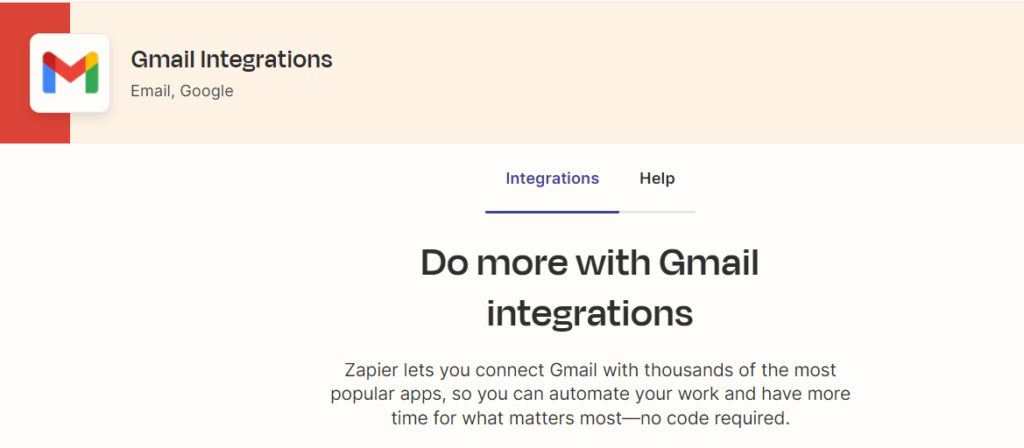
And here’s the landing page for Slack integration:
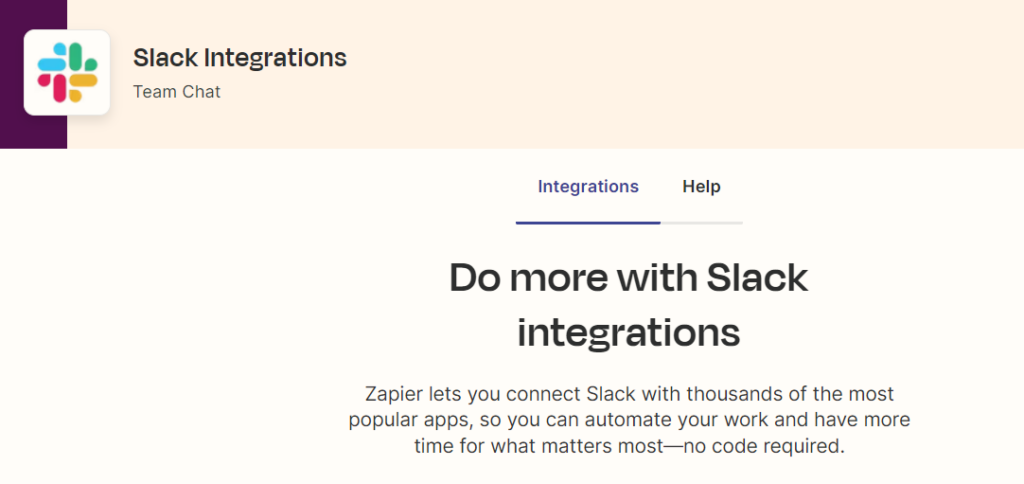
The landing pages have the same design and similar dynamic content. The reason why such automated landing pages and content aren’t demoted by Google is that they are high-value pages that aren’t aimed at manipulating search traffic, rather they are aimed at helping visitors find ways to use the Zapier app with the tool of their choice.
That’s how you should leverage AI for content marketing to stay ahead of your competition.
Key takeaway:
You need to use AI for marketing with caution and choose AI marketing tools smartly. The cost of AI tools will decrease due to fierce competition. Be ready to take advantage of it by updating your martech stack.
2. Increase in Audio Content
Podcast is a booming industry that’s expected to reach $30 billion by the end of 2024 and $131 billion by 2030. As much as 50% of marketers are already using podcasts to reach their target audiences and the percentage is expected to increase in 2024:

Audio content provides marketers with an additional touchpoint to connect with their audience. Marketers haven’t been able to get the most out of podcasts as yet which means early movers will take the lead.
Research shows that 72% of people who have listened to a podcast for 4 years have made a purchase based on the recommendation from the host. You can’t deny the marketing efficacy of podcasts, it’s just not to the mark yet because people are more tuned to video content.

Multichannel and omnichannel marketing are becoming a norm to meet customer’s expectations as reported by Gartner. The number one reason why businesses invest in multichannel marketing is for brand awareness and that’s what makes audio content important.
Podcasts might not generate massive sales but they play a crucial role in generating brand awareness and make a key marketing channel.

Investment and interest by brands and marketers in audio content will increase in 2024 and we’ll see more podcasts in response to the growing number of listeners.
Key takeaway:
Add audio content to your content marketing strategy even if you are a small business with limited resources. The more marketing touchpoints you have, the better.
3. Interactive Content will Boom
There was a significant increase in the use of interactive content in 2023. Live events and online contests are becoming increasingly popular and will continue to be an important part of content marketing in 2024.
With an increase in the number of social media users globally, it is getting increasingly important for brands to engage with their audience on social media. Live videos and events are more engaging than recorded videos. As much as 96% of consumers, according to a survey, participate in live events every year and 85% of brands see increased sales after a live event:
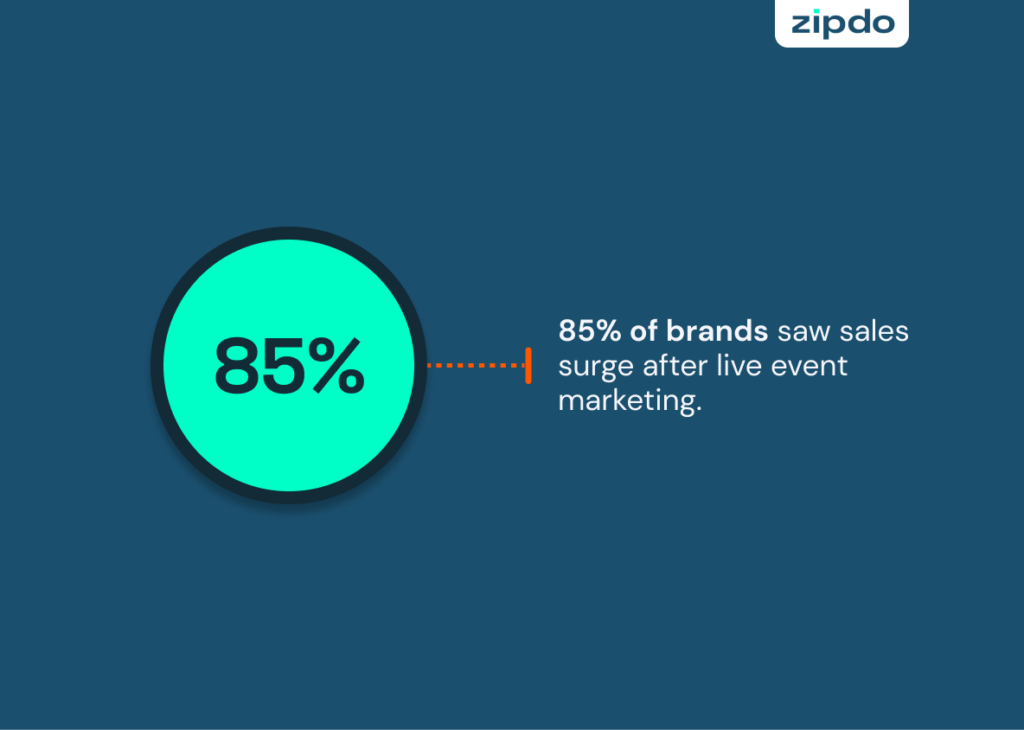
This was endorsed by Google in a study that brands that use more than one video format see an increase in ad recall and brand awareness. People prefer watching content in different forms including live videos.
Live video and events aren’t the only form of interactive content. Research shows that interactive infographics are the most used form of interactive content by marketers followed by contests:
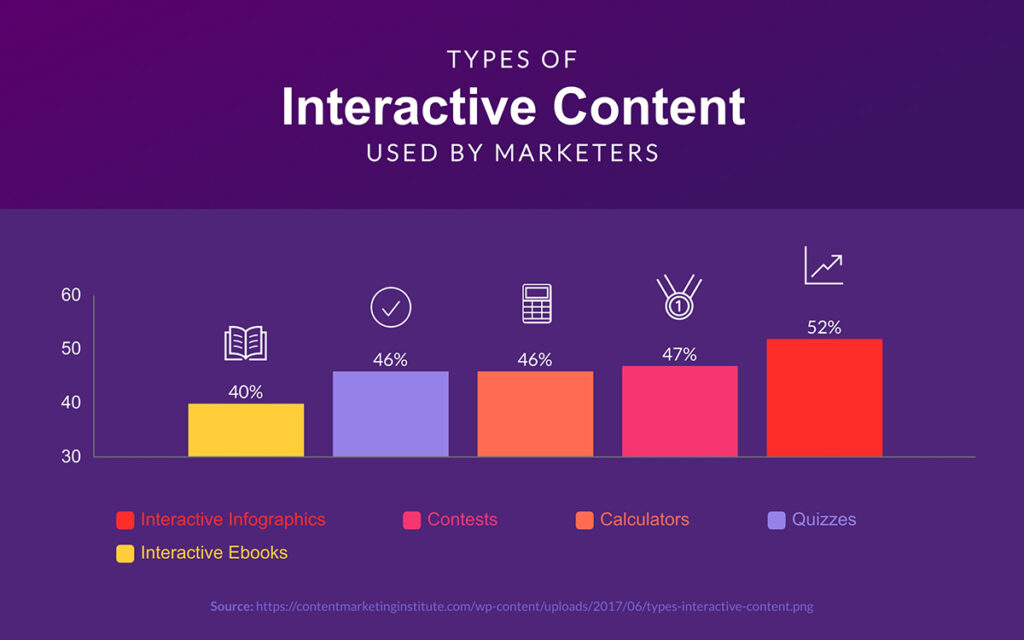
Interactive content, irrespective of its format, is more engaging, converts better, generates 5x more views, and is 93% effective in educating people as compared to the 70% effectiveness of static content:

So, what’s special about interactive content now?
There are two main reasons why more businesses will use interactive content as part of their content marketing strategies in 2024:
- AI-generated content, especially text and images, is increasing rapidly. Businesses will try to stand out from the crowd by creating more content variations and will switch to interactive content as it’s hard to replicate e.g., live video.
- Google’s focus on helpful content and updated E-A-T guidelines mean brands have to publish content that’s aimed at people, not search engines. You’ll be forced to create more interactive content as it is helpful in the true sense and offers impeccable UX.
Key takeaway:
Start creating more interactive content to outperform your competition and provide better UX to your target audience.
4. Personalization Will Be More Effective and Impactful
Personalization has a huge impact on marketing and businesses have been investing in personalized marketing campaigns for years. Artificial intelligence will help businesses of all sizes to improve content marketing personalization in 2024.
Marketers have, generally, struggled with personalization in the past due to a lack of data and resources to fully track and measure customer journey end-to-end. Artificial intelligence and predictive analysis are all set to solve these personalization challenges.
Predictive analytics is all set to improve the personalization of content across all formats and channels. It uses AI, machine learning, and statistical algorithms to predict events that help reach and target customers better with more precision. You can use it to predict the next move of your customers.

For example, predictive analytics identifies customers that are more likely to churn. You can re-engage them with personalized content via email, social networks, and blog.
This eventually leads to hyper-personalization that focuses on delivering highly personalized content to people based on their individual (instead of group) needs. One way to do this is through dynamic content that’s now used extensively in content marketing.
It is getting easier for businesses to offer 1:1 experience driven by advanced AI and data analytics tools. Social media sites are already leveraging it by personalizing news feeds of users based on their interests. If you engage with a similar type of content, you see more of it.
Content marketers will soon reach this level of personalization.
Key takeaway:
Utilize AI tools to make your content more personalized and targeted. Leverage the right tools and resources early in the year to optimize content marketing strategy.
5. Shift to Social Search
An increased number of people use social platforms to search for what they are looking for. This trend will continue to increase in 2024.
In 2023, Amazon, Walmart, TikTok, and YouTube were the top most used channels that Gen Z uses more than search engines to find what they are looking for:
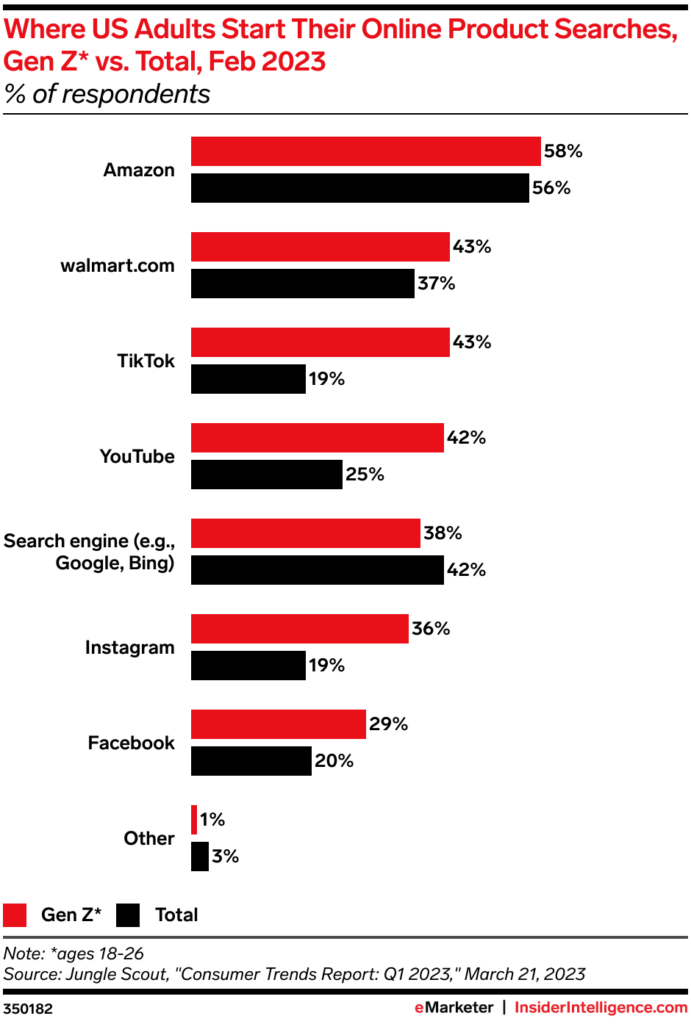
Another survey revealed that 74% of Gen Z uses TikTok search and 51% of Gen Z prefer TikTok search over Google, and the top reasons why they do so are:
- Results presented in video format
- Relatable search results
- Personalized answers.
Another 2023 survey reported that 15% of people prefer searching on social platforms over search engines with Gen Z and millennials at the top:

Google confirmed that TikTok and Instagram are giving it a tough time as these platforms are used almost by 40% of youngsters to begin their search journey. It isn’t just about TikTok or Instagram or any other particular social network, people tend to prefer using the social app of their choice to search for relevant stuff.
Businesses will do two things in response to this shift:
- Be more active on social media and focus on optimizing their accounts for social search
- Use social search such as hashtags and trending posts to find relevant keywords.
Importantly, you need to understand why people prefer social search over Google and use these insights to define and refine your content marketing strategy. As discussed above, relevance and personalization are the major reasons that persuade people to switch to social search.
This is a reason Google updated its algorithm late in 2023 and punished niche sites and low-quality content sites. Consequently, Reddit gained the most organic traffic and ranking after the helpful content update because Reddit content is based on experience, free from clutter, and gives relevant answers to the query.
Key takeaway:
Your content marketing strategy should focus on video content, relevancy driven by experience, and personalization. Use hashtags and social media sites for keyword research as Google might not show you all the keywords for your business.
6. Video Content Will Continue to Rule
The top reason why people prefer searching on social networking platforms is video content which indicates its importance. Video content will get more popular in 2024 and content marketers will respond to it accordingly.
The use of video content by businesses has increased consistently over the past years. As of 2023, 91% of companies used video content, and 96% of businesses say that video content is an essential part of their marketing strategy:
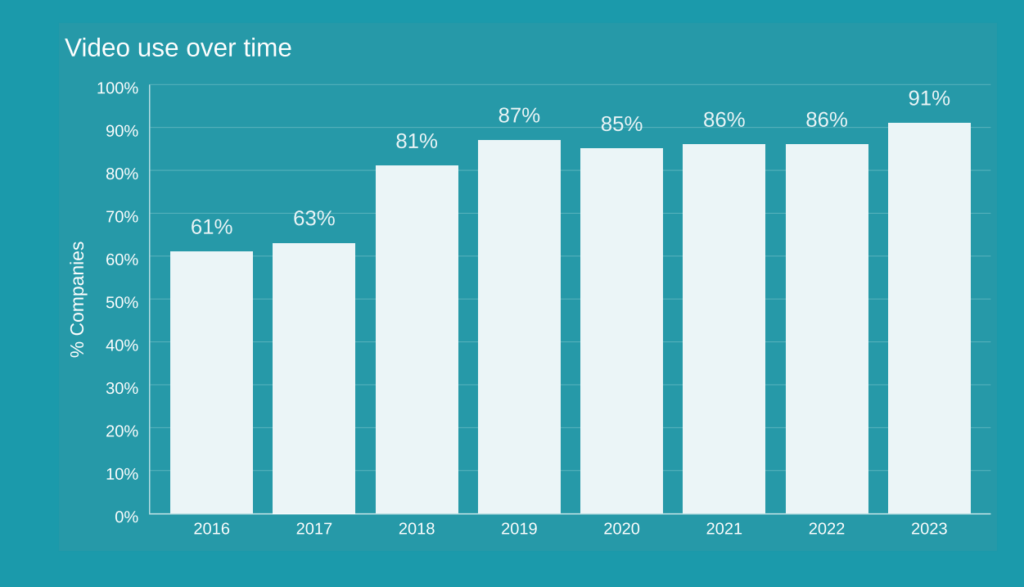
People want to see more videos from brands and the interest in video has increased over the years:
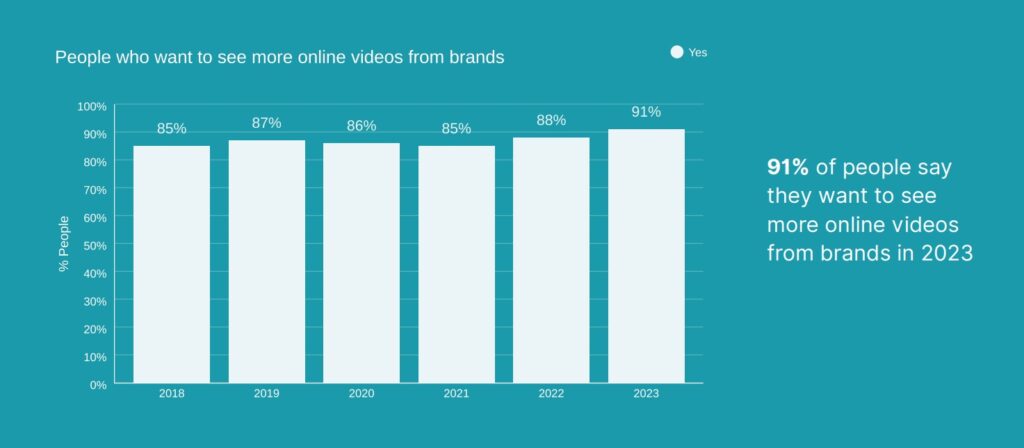
Video-first platforms (like TikTok) are getting popular (as discussed above) and businesses know it very well. So, there’ll be more video content in 2024 than the previous year and video will make an important part of content marketing.
What’s interesting is that the type of videos people want to see is also changing. For example, silent videos are getting popular and there is an increasing interest in short-form videos. Additionally, new generations (Gen Z and Alpha) are more into video content than text and this will eventually force content marketers to use videos to reach their target audience.
According to statistics, 96% of businesses are already using video for marketing and it will increase in 2024 as video content is the future of the internet. Businesses that weren’t using video due to lack of resources or high cost (as 39% of content marketers believe that video marketing is getting expensive) will also switch to video marketing due to AI tools that have now simplified how you create videos.
Creating video content is getting easier and will be even easier in the next few years as we’ll see advances in AI. Canva, for example, which is a popular design tool launched its video editor and AI video tool that generates video from text and it is free to use:
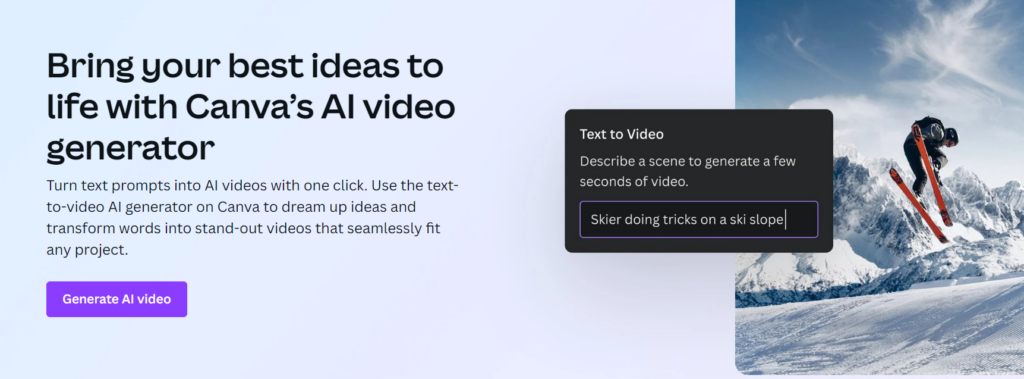
As we are expected to see more of such tools (with better functionalities) in 2024, it’ll get easier for businesses of all types to create video content at scale without spending too much money.
This obviously would have its downside as AI video content lacks personalization (which is a core pillar of marketing). Some brands will create AI videos and others will create personalized high-end video content in 2024. At the end of the day, we’ll see a lot of video content in 2024 and the consumers will decide what they like and why.
Key takeaway:
You need to create more video content in different formats. Create different types of videos to connect with your target audience. Focus on personalization. While it’s a good idea to use AI videos for your content marketing strategy, make sure you don’t overdo it.
7. Keyword Research Will Change Significantly
User behavior has changed a lot in 2023 due to search generative experience (SGE). Google and Bing now use AI-powered snippets to answer search queries right at the top of SERPs. This has significantly reduced organic CTR as most searchers find their answers right away and leave without clicking any search result.
Here’s an example:

It appears atop featured snippets which means searchers get precise answers to their search queries in two ways before they move down to the first organic search result.
Here’s what the sequence looks like in Google SERPs:
- Generative AI content
- Paid search ads
- Featured snippets
- Organic results
- People also ask
- Organic results.
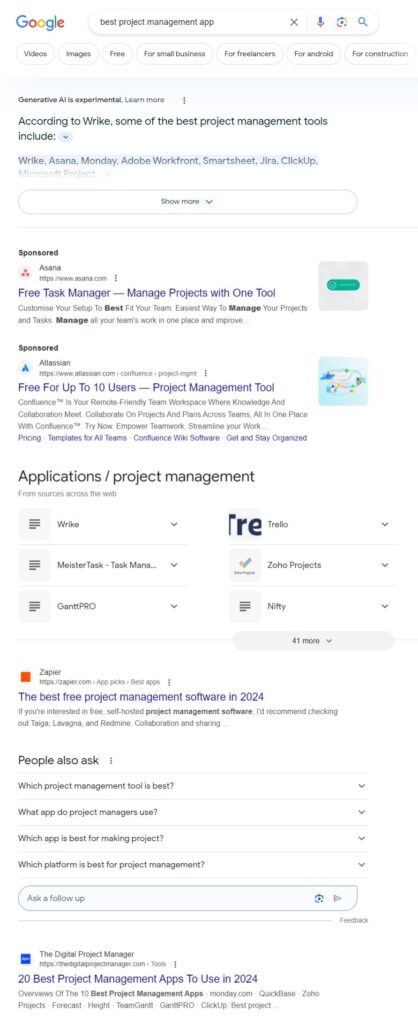
It is getting harder for your ideal customers to find your content organically in SERPs which means a reduction in organic traffic. A study reported that, on average, websites lose between 18-64% of organic traffic due to SGE:
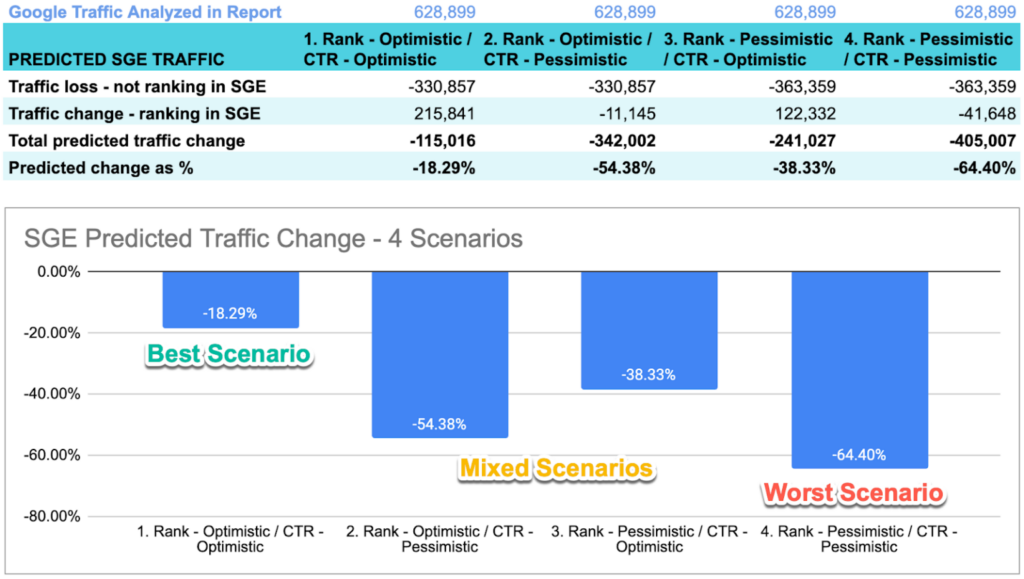
You might argue that Google and Bing are eating your traffic, but it won’t change anything. Additionally, they cite sources allowing people to click and read more if they are interested.
Here’s an example:
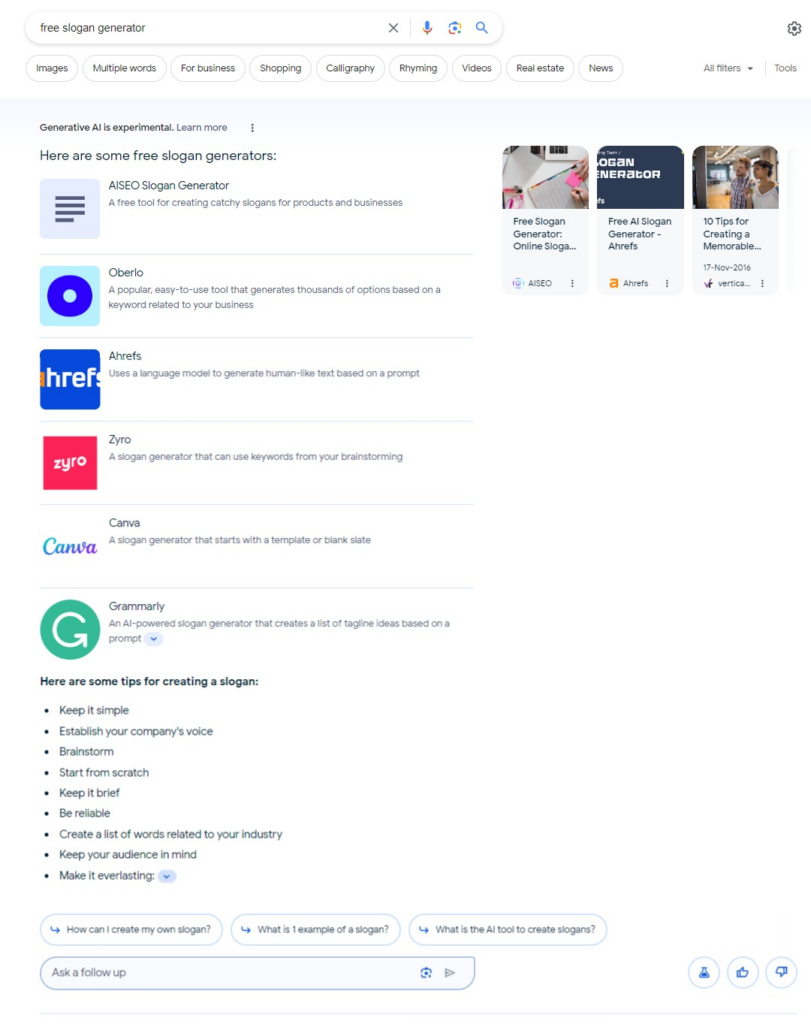
Generative AI will get better in the coming years as it learns and evolves.
It will have a huge impact on SEO and keyword research and optimization. Here’s what’s expected:
- A decline in organic traffic will push businesses to switch to PPC
- Businesses will start creating and publishing more content to increase the number of keywords they rank for
- Drastic changes in keyword research and the type of content businesses target
- More focus on experience-based content.
Targeting long-tail keywords that are already covered by several other blogs won’t help as generative AI already has a lot of stuff to create its answer. SGE, however, doesn’t work when search queries are highly personalized, unique, or advanced.
Here’s an example:

This will change keyword research and the type of content businesses publish in 2024. Businesses that find a unique angle to cover on their blogs that is consistent with the author’s experience will have a better chance to drive organic traffic and have their content featured in SGE.
Key takeaway:
Focus on keywords that are strictly related to your product or business. Target commercial and transactional keywords. Write opinion-based, extremely niche, and experience-driven content to increase the probability of getting picked up by SGE so that people can click and visit your site from within AI answers.
Use These Trends to Improve Your Content Marketing Strategy
Now that you know what’s expected in the coming year, you are in a better position to prepare yourself. Revisit your content marketing strategy and see if it covers all these trends. Refine and revise it if it doesn’t account for all these factors.
Among so many content marketing variables to consider next year, one thing that stands out is experience-based content. Whether it is a blog post, a short video, or a podcast, you have to showcase your experience and authenticity. Both Google and people love it.
Your response to these trends is what makes the difference.
Featured image: Unsplash



